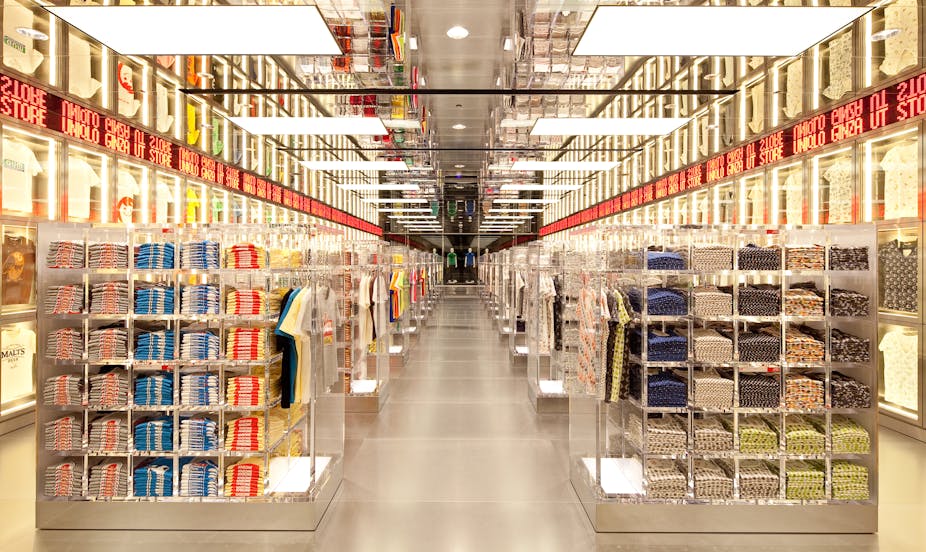Japanese fashion label Uniqlo and homeware store Muji will enter the Australian market next year, following other recent arrivals H&M, Topshop and Zara.
Despite the purported decline of brick and mortar stores, Australian shoppers will finally be able to shop at stores they’d once only encountered overseas.
It seems a far cry from only a few years ago. In 2007 I published a study looking at the internationalisation of retailing in Australia, and made the following argument:
A very geographically dispersed and isolated retail environment, which modernised concurrently with the most likely sources of FDI [foreign direct investment], has not proven attractive to international retailers. Of the world’s 250 largest retailers, only 16 operate in Australia, of which 13 are foreign-owned firms.
Seven years later (the data was based on Deloitte’s 2006 Global Powers of Retailing report), the competitive landscape has shifted considerably.
Counting impending openings by H&M and Uniqlo, we will soon be host to 27 of the world’s largest 250 retailers. Two of these - Woolworths and Wesfarmers - are domestic (the 2007 acquisition of Coles by Wesfarmers reduced our count).
Three from the recent arrivals have been from the top 50 retailers: Costco, Lowes and Inditex (parent of Zara). Three more are from the top 100: The Gap, Apple, PPR (French owner of various luxury and sports marques).
Australia is no longer quite the retail backwater it once was. So what’s changed in such a short period of time?
Some have been changes affecting the world, others specific to Australia.
Around the world, retailers are on the move. The average number of countries in which the top 250 retailers operate is now nine, up from 5.5 in 2006.
These expansions come through acquisition - like South African Steinhoff’s purchase of furniture retailer Freedom - franchising, or joint ventures - US hardware giant Lowes has partnered with Woolworths on the Masters rollout. Or, like Costco and Inditex, retailers choose to go it alone.
Such firms are expanding overseas with the confidence their business model is transferable elsewhere, and because they have distinct offerings such as IKEA, Abercombie and Fitch, Aldi and Fast Retailing (the Uniqlo parent).
Others are giants at home, and have hit diminishing returns from opening new stores there. Many have built international supply chains to support domestic growth and want to use these networks in other markets.
And the emergence of online sales has also allowed firms to further exploit these supply chains, to test markets from afar, while prompting the establishment of a physical presence to generate a “buzz” through brand awareness.
Don’t forget about us
This last reason is an important part of the Australian growth story. International brands, especially in the fashion retails, have prominent online presence here.
Australia was one of the largest online markets for UK firm Arcadia (owner of Topshop), well before they committed to a bricks-and-mortar presence.
Now they’ve taken the data from online stores - what customers want, when they want it, what they are willing to pay - and used it to reduce the uncertainty multinationals normally face when entering a foreign market.
More locally, Australia is increasingly attractive because, despite all the gloom, the economy has been growing consistently for the past two decades. And that is rare among the OECD nations.
And for relatively timid US retailers (who still tend to be underrepresented in non-English and non-Spanish speaking markets), Australia is culturally “close to home”.
For all except the international supermarket chains, Australia’s retail infrastructure has also improved considerably. Property developers, lead by Westfield, are competing furiously to attract global brands as anchor tenants for their sites.
There is definitely a contagion among the big brands (and developers) not to be left out.
The final explanation is not quite as flattering. In many instances, Australia is an afterthought.
The world’s largest commercial real estate services firm, CBRE, tracks the presence of 326 of the world’s most prominent retail brands across 208 cities in 73 countries.
Australia ranks 30th, trailing Qatar, Russia, Poland and Thailand, and is only just ahead of Hungary. Melbourne is our most international city at equal #61 with Bucharest, but behind Jeddah, Birmingham and Shenzen.
It would appear that it’s a case of the more adventurous retailers finally ticking us off their list.

